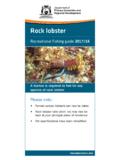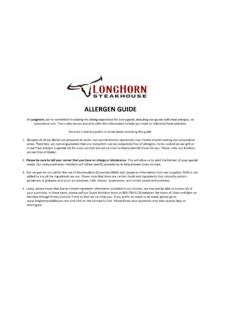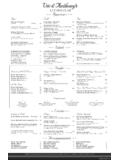Transcription of The world lobster market - Food and Agriculture ...
1 GLOBEFISH RESEARCH PROGRAMME. The world lobster market Volume 123. FAO GLOBEFISH RESEARCH PROGRAMME VOL. 123. The world lobster market by Graciela Pereira Helga Josupeit FAO Consultants Products, Trade and Marketing Branch Fisheries and Aquaculture Policy and Resources Division Rome, Italy FOOD AND Agriculture ORGANIZATION OF THE UNITED NATIONS. Rome, 2017. The designations employed and the presentation of material in this information product do not imply the expression of any opinion whatsoever on the part of the Food and Agriculture Organization of the United Nations (FAO) concerning the legal or development status of any country, territory, city or area or of its authorities, or concerning the delimitation of its frontiers or boundaries. The mention of specific companies or products of manufacturers, whether or not these have been patented, does not imply that these have been endorsed or recommended by FAO in preference to others of a similar nature that are not mentioned.
2 The views expressed in this information product are those of the author(s) and do not necessarily reflect the views or policies of FAO. ISBN 978-92-5-109631-4. FAO, 2017. FAO encourages the use, reproduction and dissemination of material in this information product. Except where otherwise indicated, material may be copied, downloaded and printed for private study, research and teaching purposes, or for use in non-commercial products or services, provided that appropriate acknowledgement of FAO as the source and copyright holder is given and that FAO's endorsement of users' views, products or services is not implied in any way. All requests for translation and adaptation rights, and for resale and other commercial use rights should be made via or addressed to FAO information products are available on the FAO website ( ) and can be purchased through FAO. January 2017. The world lobster market , by Graciela Pereira and Helga Josupeit, FAO Consultants.
3 Globefish Research Programme Volume 123. Rome, Italy. ABSTRACT. This is a report on the size of the market for Caribbean spiny lobster (Panulirus argus), the biggest market players (traders, retailers, restaurant chains) and their relationship to producers in Central America in order to contentualize the market for Caribbean spiny lobster . General aspects of the lobster market are discussed in detail, including all types of lobster species and harvesting methods used in the geographic area under analysis. Layout: Gloria Loriente Cover photograph: Courtesy of Graciela Pereira iii TABLE OF CONTENTS. 1. INTRODUCTION 1 2. LOBSTERS AND lobster PRODUCTION 2 CARIBBEAN SPINY lobster 6 Honduras and Nicaragua 7 lobster MANAGEMENT SYSTEMS IN THE CARIBBEAN 8 Honduras and Nicaragua 9 3. PRODUCT FORMS AND VALUE ADDITION FOR ALL TYPES OF. lobster 11 4. TRADE OF ALL lobster SPECIES 13 5. MAIN MARKETS FOR ALL LOBSTERS 15 NORTH AMERICA 15 United States of America 15 Canada 18 CHINA 19 China mainland 19 China, Hong Kong (SAR) 20 EUROPE 20 France 21 Spain 23 Italy 24 6.
4 EXPORTS 26 NICARAGUA 26 HONDURAS 27 7. CONCLUSION 28 8. REFERENCES 31 iv FIGURES. 1. lobster prices, United States of America, France and China, 1990 2014. (unit value of imports) 14. 2. Prices of lobster tails imported from Nicaragua and Honduras to the United States of America, July 2011 July 2015 17. 3. Prices of European lobster imported from Ireland to Europe, October 2010 October 2015 22. 4. Unit value of lobster (US$/tonne), 2004 2014, calculated based on the Global Trade Information System (GTIS) 27. TABLES. 1. Total world lobster production by country of origin (tonnes) 3. 2. world lobster landings by species, 1980, 1990, 2000, 2010, 2012 and 2013 (tonnes) 5. 3. Total Caribbean spiny lobster production, 1980, 1990, 2000, 2010, 2012 and 2013 (tonnes) 7. 4. world : Quantity of lobster imports, 2009 2014 (tonnes) 13. 5. world lobster imports, 2009 2014 (US$ million) 13. 6. United States of America: Quantity of lobster imports, 2009 2014 (tonnes) 16.
5 7. Value of US imports of lobster , 2009 2014 (US$ million) 18. 8. China: Quantities of lobster imports, 2009 2014 (tonnes) 19. 9. China, Hong Kong SAR: Quantity of lobster imports, 2009 014 (tonnes) 20. 10. France: Quantities of lobster imports, 2009 2014 (tonnes) 21. 11. France: Value of lobster imports, 2009 2014 (US$ million) 22. 12. Spain: Quantities of lobster imports, 2009 2014 (tonnes) 23. 13. Spain: Value of lobster imports, 2009 2014 (US$ million) 24. 14. Italy: Quantities of lobster imports, 2009 2014 (tonnes) 25. 15. Nicaragua: Quantity of lobster exports, 2007 2014 (tonnes) 26. 16. Honduras: Quantity of lobster exports (tonnes) 27. 17. world : Quantity of lobster imports, 2007 2012 (tonnes) 29. 18. world : Value of lobster imports, 2007 2012 (US$ million) 30. v 1. INTRODUCTION. This is a report on the size of the market for Caribbean spiny lobster (Panulirus argus), the biggest market players (traders, retailers, restaurant chains) and their relationship to producers in Central America.
6 In order to put the market for Caribbean spiny lobster into the correct context, general aspects of the lobster market are discussed in detail, including all types of lobster species. It will also discuss the harvesting methods used in the geographic area under analysis. This report will serve as a basis for a feasibility study on market -based incentive schemes for selling product produced through decent employment, which would exclude, for example, the use of scuba diving as practised in in Honduras and Nicaragua. The main purpose of the market -based incentive scheme will be to reduce the market demand to zero for lobster harvested by scuba diving. In the preparation for this study, some of the main importers of lobster in Florida were interviewed as well as supermarket clients and restaurant owners in order to perceive the sensitivity of consumers to lobster harvest and the risks involved for scuba divers. 1. 2. LOBSTERS AND lobster PRODUCTION.
7 The category lobster comprises four main commercial species: European lobster (Homarus gammarus), American lobster (Homarus americanus), rock lobster (Jasus spp.) and tropical or spiny lobster (Panulirus spp. or Palinurus spp.). Since lobster is a highly prized delicacy throughout the world , there are many ongoing technical advances in all the major lobster producing countries to ensure that stocks will remain sustainable for future generations. These include the development of hatchery techniques to enhance fisheries, which have been successful for the Homarus species and which are in the trial stages for rock lobster . Given that live lobster is such a valuable export commodity, considerable time and effort have been devoted to developing its storage methods and overland and airfreight transport systems in order to ensure that it reaches the restaurant or consumer in prime condition. The processed lobster market has also developed considerably in recent years, with companies seeking to make lobster products more easily accessible to the consumer.
8 Simple processes such as ready-cracked claws and meat selection packs in attractive packaging have contributed to an increase in demand. With regard to value added, live lobster fetches the highest price, thus greater efforts are being made to ensure that the species reaches the market place alive. lobster aquaculture is still in its infancy. 2. Table 1. Total world lobster production by country of origin (tonnes). 1980 1990 2000 2010 2012 2013. Canada 20 089 47 857 45 331 67 277 74 790 74 686. United States of 19 873 30 906 40 662 55 253 70 020 70 535. America Indonesia 216 826 3 596 7 651 13 549 16 482. Australia 14 456 15 266 19 837 11 462 9 756 11 301. Brazil 8 023 9 223 6 469 6 866 7 386 6 726. Bahamas 2 894 5 808 9 023 9 692 9 761 6 088. Cuba 10 567 7 957 7 478 4 458 4 467 4 621. Nigeria - 2 600 1 939 4 398 4 289 4 586. Nicaragua 1 849 783 6 534 3 800 4 427 4 494. Mexico 2 530 2 358 2 799 3 260 3 041 3 535. United Kingdom 774 1 444 1 156 2 754 3 104 2 993.
9 New Zealand 4 615 3 122 2 824 2 906 2 699 2 820. Dominican 166 750 F 1 286 1 001 2 505 2 542. Republic South Africa 6 841 4 856 2 006 4 121 2 507 2 514. Zanzibar - - 306 396 1 682 1 695. Honduras 2 199 4 012 2 470 3 151 1 556 1 658. Pakistan 48 470 807 1 029 1 246 1 356. Malaysia 2 691 1 103 730 794 857. Others 13 772 14 537 10 386 11 441 10 575 10 466. Total 110 894 154 706 168 012 203 656 230 166 231 968. Note: F are FAO estimates. Source: FAO (2015). FishStatJ. Landings in the United States of America and Canada combined account for more than half of all world landings of all lobster . Total US and Canadian landings of American lobster have increased steadily over the past five to six years. In 2007, a total of 86 000. tonnes were landed by the two countries, which in 2015, was estimated to have increased to 146 000 tonnes. As a result, supplies are abundant, yet the increase in supplies seems to have had only a marginal effect on prices, as demand in new markets such as China is growing rapidly.
10 The unusually warm weather in New England extended the lobster season into December 2015. According to the Associated Press, the extended season has not had an effect on prices, which were around US$8 10 per pound in Maine in December 2015. Researchers found that the lobster population in New England is increasing, which they attribute to climate change and warmer waters. Australia is also an important player in the global market , with landings of around 11 300 tonnes in 2013. Other countries landing significant quantities include Brazil, Bahamas and Cuba. Landings in Indonesia have shown consistent growth over the years, a trend that is expected to continue. 3. In 2013, Nicaragua ranked eight among world lobster producers with 4 400 tonnes, while Honduras ranked 15th (1 650 tonnes). Both countries produced far more lobster in the past: Nicaraguan lobster production peaked at 6 500 tonnes in 2000, while Honduras peaked at 4 300 in 1986.


















